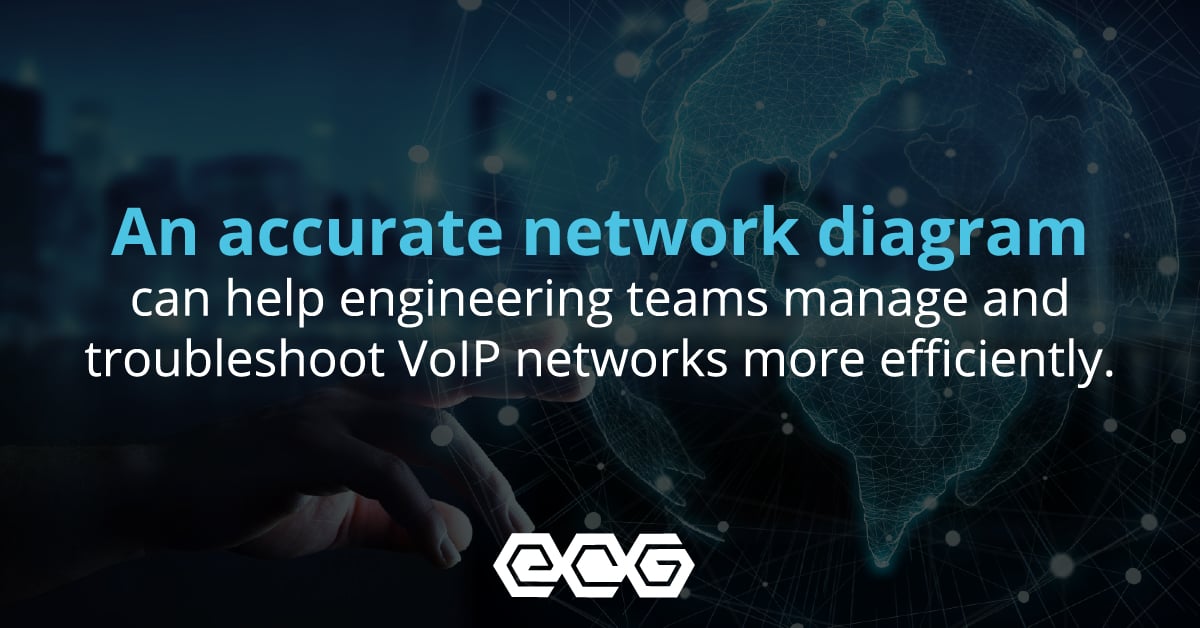Whether you’re a broadband service provider, a VoIP telephone provider, a small office, or a large, distributed enterprise, the structure of your network plays a major role in how well your systems – and teams – function. That structure is called network architecture, and understanding it can help you make smarter decisions as your organization grows.
Read on to learn what network architecture is, how it works, and how to design a network architecture that supports the technologies your business relies on every day.
What Is Network Architecture?
Network architecture is the design that outlines how different parts of a computer network – including physical hardware (like routers and switches) but primarily the logical components (like IP addressing and routing rules, VPNs, and virtual servers) – connect, communicate, and operate together.
An effective architecture ensures that a network can run efficiently for your current needs, adapt to changes, and scale over time. It defines the flow of data, how different systems interact, and how devices like computers, phones, and servers talk to each other, whether they’re in the same building or across the globe.

For service providers and enterprise organizations, the architecture is even more important. These networks must support millions of customers, survive inevitable failures in equipment and links, provide secure cloud services, and protect the privacy and security of all that data. Still, the goal remains the same: provide fast, secure, and reliable connectivity.
What Is a Network Architect?
Every strong network architecture has at least one network architect behind it. These professionals design and maintain network systems while making sure the technical details match your business goals.
A network architect evaluates the current design, understands potential problems and limitations, and tests solutions to meet reliability, performance, and security needs. Their work goes beyond just picking switches and routers; they focus on creating long-term success through smart, scalable network planning.
For VoIP service providers and broadband network operators, a network architect's job is ultimately to deliver the service offerings for customers – and to do so at the lowest possible internal costs. However, network architects can’t just focus on building inexpensively based on direct costs. They also need to include the total costs, including support costs, direct costs like licensing and hosting, and the ability to operate and sell the services in the calculations.
Common Network Architecture Types
The right network architecture will depend on your organization’s size, structure, and business goals. The most popular paradigms, which are commonly mixed and matched when building a network, are:
Cloud Network Architecture
Cloud network architecture supports environments built entirely in the cloud – a must, considering cloud spend is expected to increase by 28% this year.2 It relies on virtual components such as virtual private clouds, cloud firewalls, and elastic load balancers to provide a flexible infrastructure that grows with your business.
Cloud network architecture is every bit as complex as physical or virtualized network architectures. Each cloud provider – whether AWS, Google Cloud (GCP), or Azure – has nuances of their network, security, and compute designs. A network architect has to understand them in an environment where the wrong deployment can lead to massive explosions in monthly recurring costs.

Local Area Network (LAN)
A LAN connects computers and devices within a small geographic area, like an office or building. These networks are fast, affordable, and easy to manage, which is why businesses often use them to support daily operations and internal communications. VoIP and broadband service providers support their customers' networks and operate local networks for data centers, cell/radio sites, and their own enterprise operations.
Virtualized Networks
While every network relies on some cables, spectrum, and equipment, many networks are highly virtualized. These networks consist of Virtual LANs (VLANs), Virtual Routing and Forwarding (VRF), Virtual Private Networks (VPNs), Software-Defined Networks (SD-WAN), and Virtual Servers, which determine their design and operations. Virtual networks tend to be less expensive in terms of equipment and cabling complexity, but more complex in terms of intelligence and the importance of design.
Wide Area Network (WAN)
A WAN connects multiple LANs across large distances, sometimes cities or continents. Enterprises use WANs to link branch offices, data centers, and cloud platforms, which enables employees in different cities to work together as if they were in the same building. Service providers will typically operate their network in large regions or markets and assist their customers in providing WAN resources.
Application Layer Networks
Most of this discussion has talked about the packet delivery network and security appliances. But built on top of the network for delivering packets and establishing connections, we have applications – such as voice. For voice service providers, the design of the voice network architecture is an additional activity that rides on top of the underlying architecture.
In general, architects say that the lower layers of an application layer network (like IP routing) exist to serve and enable the upper layers of the network (like voice). Voice service providers only run the lower layers of a network to allow the upper application layers to function.
Software-Defined Wide Area Network (SD-WAN)
SD-WAN introduces a software layer that makes it easier to manage and optimize network traffic across multiple sites. It allows teams to prioritize important apps, improve performance, and simplify cloud connectivity, which could be why the SD-WAN market is expected to reach $13.7 billion by 2026.1

Components of Data Network Architecture Design
No matter the type, all network architectures are built using a few essential building blocks:
- Applications: These provide the purpose for running the data network.
- Routers and Switches: Routers manage traffic between networks, while switches manage traffic in a single network. Cloud-based networks still have these, even if they're called by different names.
- Firewalls and Security Gateways: Security components monitor and control incoming and outgoing traffic, often serving as the first line of defense against cyber threats. Web Application Firewalls are one of the primary types of security gateways used in service provider networks.
- Endpoints: Endpoints like phones, laptops, and servers, or Virtual Network Functions (VNFs) work as the final nodes in a network conversation.
- Protocols and Addressing: Protocols like TCP/IP define how data is transmitted and received. Addressing schemes, like IP addresses and subnetting, ensure devices know where to send data. Addressing becomes more complex in multi-VRF MPLS environments, where 192.168.0.1 can exist on a million devices.
- Network Management Tools: These platforms provide visibility into network performance, device health, and security status, enabling proactive maintenance and troubleshooting.
Together, these components help ensure your network is reliable, secure, and ready to meet business needs.
Components of Voice Network Architecture Design
The components we mention above cover the essentials for data networking – moving packets between endpoints. But what about the voice network? Common elements exist there, too, and are the design patterns for the voice network architect. These include:
- Network-to-Network Interface (NNI): These are logical interfaces where one network talks to another, e.g., XYZTelco sends traffic to ABCTelco. Often this is called "peering".
- User-to-Network Interface (UNI): This is the logical point where a customer communicates with the voice network. Sometimes this is called an "access interface".
- Session Border Controllers (SBCs): SBCs are the software (and occasionally dedicated hardware) that allow UNI and NNI interfaces to connect to each other.
- PSTN Connectivity: This is a special kind of NNI where a voice provider communicates to another provider who can reach "the rest of the world." These are the points where a voice network can send phone calls to get to other destinations within the country or globally.
- Application Servers: Software on servers, or serverless network functions, provide features like voicemail, advanced call routing, or call center queueing functions.
- Voice Endpoints: If a voice service provider hosts subscribers and assigns phone numbers to them, we think of them as an ordinary "telco." The software or devices used by those subscribers constitute the voice endpoints.
Together, these enable voice service providers to deliver reliable, high-quality calling services to their customers.
7 Network Architecture Design Best Practices
A good networking architecture doesn’t happen by accident. It results from careful planning, clear goals, and well-established practices. Here are some practices to help you build a strong, future-ready network:
1. Centralize Visibility – Observability
It’s easier to maintain performance and spot issues when you can see what’s happening across your network. Visibility tools like real-time monitoring platforms, which are a top priority for 64% of security leaders in 2025,3 help teams detect issues, track performance, and enforce policies from a single interface.

2. Plan for Scalability & Evolution
Strong network design accounts for future growth, which means understanding not just your company's current needs but also where it's heading. This includes considering new technologies, changing work patterns, and evolving security requirements.
3. Prioritize Security
Security can’t be an afterthought. From access controls to encrypted traffic, your network architecture should enforce security policies across endpoints, data flows, and administrative access. Additionally, cybersecurity must account for the threat actors working against your network – for example, the US Department of Justice has different adversaries than a manufacturing firm or dental practice.
4. Embrace Segmentation
Segmenting traffic between departments or services reduces the attack surface and improves performance. VLANs, firewalls, and microsegmentation strategies play a key role in secure network architecture. Zero Trust Networking is the end-game of segmentation, as it ensures the job of connecting devices to each other isn’t a replacement for authentication and authorization (i.e., two nearby services do not automatically need to trust one another).
5. Implement Redundancy
Backup connections and failover systems ensure continuity during outages or equipment failures. It typically includes implementing multiple paths for data, backup power systems, and procedures for quickly switching to alternate systems when problems occur.
6. Optimize for App Performance
A 2025 report revealed that companies use an average of 101 applications4 – and many modern apps require low latency and consistent throughput to perform properly. Your network architecture should prioritize real-time applications (like video conferencing and VoIP) with the right bandwidth and QoS settings.
7. Align Architecture to Business Application Needs
A good network supports the business, not the other way around. Your design should reflect how your team works, what tools they need, and what compliance or operational requirements are in place.

Network Architecture Examples in the Real World
Let's look at how these concepts work in actual business situations:
AI & Voice Service Provider
A voice service provider offering PSTN connectivity and advanced AI services may use a mixture of cloud-based and data-center-hosted services. They may use TDM interconnects into IP network equipment in those data centers, with VPNs connecting to their larger compute server resources in a cloud provider. SD-WAN can be used to connect data centers together, or where fiber is affordable, direct connects over dark fiber.
Retail Chain
A retail chain with multiple locations might use SD-WAN to link each store to a cloud data center. Each store has a LAN with VLAN segmentation for POS systems, customer Wi-Fi, and back-office operations, all secured by firewalls and managed remotely. The back-office inventory system in a legacy IBM S390 server could run in a physical data center, while the website runs with a hosting provider with API connectivity to the data center.
Healthcare System
A hospital network might rely on a private WAN to connect clinics and hospitals. Security is a top concern, so each department’s traffic is segmented, while sensitive data like electronic health records is shared through encrypted tunnels.
Broadband Service Provider
An internet service provider may combine fiber links and private 5G (Fixed Wireless Access) links to deliver service. Their core data centers could use routers, switches, and accessory servers to provide data services to customers, while the broadband provider’s back office and marketing operations can run on cloud-hosted services to minimize security management.
Cloud-First Startup
A startup with a remote team may use a cloud-native network architecture with all infrastructure hosted in cloud platforms like AWS. With this approach, the startup can grow quickly without investing in physical infrastructure.
Build a Smarter Enterprise Network Architecture With ECG
At ECG, we design, support, and optimize voice and data network architectures for service providers and businesses operating at scale. Our engineering experts bring decades of experience in both traditional and cloud-native environments to help you:
- Plan a scalable, secure, and high-performance network architecture
- Align infrastructure with business and compliance requirements
- Troubleshoot complex routing and QoS issues
- Integrate security, redundancy, and cloud connectivity from the ground up
Whether you’re overhauling legacy systems or building a new network, we’re here to help you do it right the first time. Contact ECG today to start designing your next-generation network.
Sources:
- https://www.marketsandmarkets.com/Market-Reports/software-defined-wan-market-53110642.html
- https://www.flexera.com/about-us/press-center/new-flexera-report-finds-84-percent-of-organizations-struggle-to-manage-cloud-spend
- https://www.gigamon.com/campaigns/hybrid-cloud-security-survey.html
- https://www.okta.com/newsroom/articles/businesses-at-work-2025


